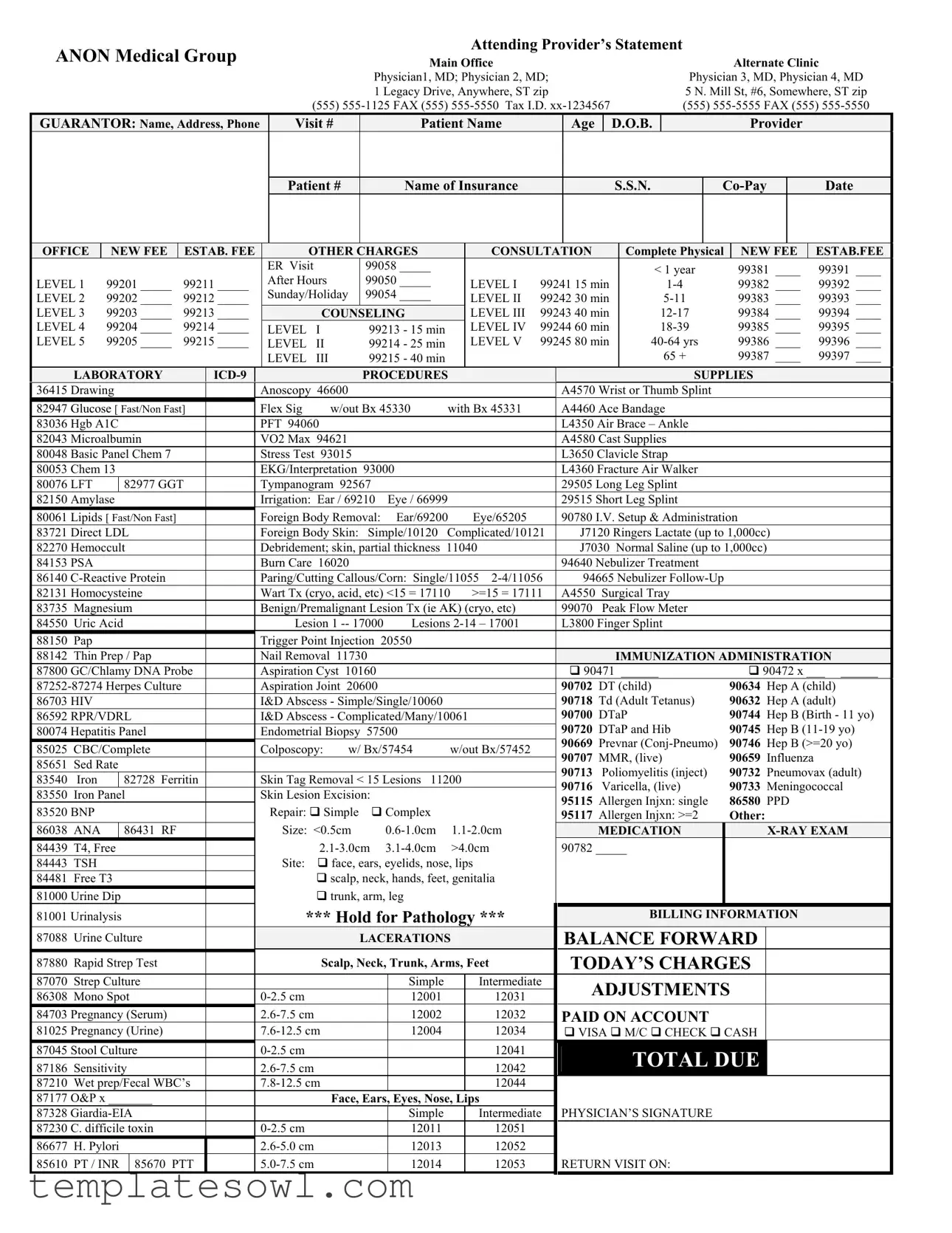Infectious & Parasitic Dis
098.0Gonorrhea, acute
042 HIV
075 Mono/Infectious mononucleosis
487.1Influenza w/ upper respiratory
795.5Positive PPD
079.9Viral Syndrome
Neoplasms
Malignant Neoplasms
174.9Breast, female, unsp
153.9Colon, unsp
162.9Lung, unsp
185 Prostate
173.9Skin, unsp
Benign Neoplasms
214.9Lipoma, any site
216.9Skin, unsp
218.9Uterus (leiomyoma, unsp.
Endo, Nutr & Meta. Dz
250.91Diab. mell., I, complicated
250.01Diab. mell, I, uncomplicated
250.90Diab.mell, II, complicated
250.00Diab.mell, II, uncomplicated
790.6Elevated sugars / Hyperglycemia/Iron
271.3Glucose intolerance
240.9Goiter, unspecified
274.9Gout, unspecified
272.4Hyperlipidimia
272.0Hypercholesterolemia
242.90Hyperthyroidism, NOS
276.8Hypokalemia
244.9Hypothyroidism, unsp
278.00Obesity/Overweight; Morbid 278.01
241.0Thyroid nodule
Blood Diseases
280.9Anemia, iron deficiency
281.0Anemia,Pernicious/ B12 Def.
285.9Anemia, unspecified
683 Lymphadenitis, acute
Mental Disorders
309.9Adjustment reaction unsp
305.00Alcohol abuse, unsp
303.90Alcoholism, unsp
331.0Alzheimers
307.1Anorexia nervosa
300.00Anxiety state, unsp
314.01ADD w/ hyperactivity
314.00ADD w/o hyperactivity
296.40Bipolar Disorder
307.51Bulimia
311 Depressive disorder, NOS
296.20Depression, Acute
305.90Drug abuse, unsp
304.90Drug dependence, unsp
780.52Insomia NOS
300.01Panic disorder
301.9Personality disorder unsp
290.0Senile dementia, NOS
302.70Sexual dysfunction,
780.50Sleep Disturbance
305.1Tobacco abuse
Nerve/Sense Disorders
354.0Carpal tunnel syndrome
432.9CVA/ Intracranial hemorrhage NOS
345.90Epilepsy, unsp w/o intractab
784.0Headache
307.81Headache, Tension
346.90Headache, Migraine, w/o intractable
357.9Neuropathy, unsp
310.2Postconcussion
333.99Restless legs
780.39Seizures, convulsions
333.1Tremor, essential
Eye Diseases
373.00Blepharitis, unsp
366.9Cataract, unsp
373.2Chalazion
372.00Conjunctivitis, Acute, Bact.
372.14Conjunctivitis, Allergic
077.99Conjunctivitis, Viral
918.1Corneal abrasion
930.9Eye foreign body, external
365.9Glaucoma, unsp.
373.11Hordeolum (stye)
368.10Visual disturbance, unsp
369.9Visual loss, unsp.
Ear Diseases
380.4Cerumen, Impacted
381.81Eustachian tube dysfunction
389.9Hearing loss, unsp
380.10 Otitis externa, unsp
382.00Otitis media, acute
381.10Otitis media, chronic
386.2Vertigo, central
386.10Vertigo, peripheral
Circulatory System
413.9Angina pectoris, stable
424.1Aortic Valve disorder
427.9Arrythmia
414.00ASHD
427.31Atrial Fibrillation
414.9CAD / Ischemic heart disease
426.9Conduction disorder unsp
428.0CHF
453.9DVT/Deep Venous Thrombosis
796.2Elevated BP w/o hypertension
401.1Hypertension, benign
401.0Hypertension, malignant
424.0Mitral Valve / MVP
412 Myocardial infarction, old
458.0Orthostatic hypotension
427.0Paroxysmal supraventricular
420.91Pericarditis, acute
443.9Peripheral vascular disease
427.60Premature beats unsp
427.69PVC/Premature Ventricular Contract.
415.19Pulmonary embolism
427.81Sick Sinus Syndrome
451.9Thrombophlebitis unsp
435.9TIA/Transient ischemic attack, unsp
454.9Varicose veins w/o ulcer/inflam
459.81Venous insufficienciency
427.1V-tach/Ventricular tachycardia
Respiratory System
493.90 Asthma, unsp.
466.11Bronchiolitis, acute, due to rsv
466.0Bronchitis, acute
491.9Bronchitis, chronic
496 COPD
464.4Croup
492.8Emphysema
799.0Hypoxia
464.0Laryngitis, acute
462 Pharyngitis, acute
472.1Pharyngitis, chronic
519.1R.A.D
486 Pneumonia, unsp
477.9Rhinitis, allergic
472.0Rhinitis, chronic
461.9Sinusitis, acute
473.9Sinusitis, chronic
034.0Strep throat
463 Tonsillitis, acute
465.9URI, acute
Digestive System
571.9Chronic liver disorder
571.5Cirrhosis, NOS
562.10Diverticulosis colon
536.8Dyspepsia
530.10Esophagitis, unsp
575.9Gallbladder disease
535.50Gastritis, w/o hemorrhage
009.1Gastroenteritis, infectious
558.9Gastroenteritis, noninfectious
530.11GERD
578.9GI Bleeding
007.1Giardiasis
455.6Hemorrhoids, NOS
070.30Hepatitis B
070.51Hepatitis C
Hernia: hiatal/553.3; inguinal/550.90
553.9Hernias, other, NOS
560.1Ileus
564.1Irritable bowel syndrome
792.1Occult Blood in stool
528.9Oral, soft tissue disease/Mouth Ulcer
529.9Oral, tongue disease
577.0Pancreatitis, acute
533.90Peptic ulcer disease
569.3Rectal bleeding
524.60Temporomandibular joint disorder
112.0Thrush, oral yeast
Genitourinary System
Renal Failure: Acute/584.9 Chronic/585
580.9Glomerulonephritis, acute
592.9Kidney Stone
791.0Proteinuria, nonpost ural
590.10Pyelonephritis, acute
599.0UTI (NOS)
Male Genital Organ Disease
302.72Erectal Dysfunction
604.90Orchitis/epididymitis
600.0BPH / Prostatic hypertrophy
601.9Prostatitis, acute
456.4Varicocele
Breast Diseases
611.72Breast lump / mass
610.1Fibrocystic disease
611.6Galactorrhea
Female Genital Organ Diseases
622.1Cervical dysplasia
622.7Cervical polyp, NOS
616.0Cervicitis
625.0Dyspareunia
617.9Endometriosis, unsp
626.4Irregular menses
614.9PID / Pelvic inflammatory disease
625.6Stress incontinence, .female
131.9Trichomoniasis, unsp
616.10Vaginitis/vulvitis
112.1Vaginitis, Yeast Disorders of Menstruation
626.0Amenorrhea
626.2Excessive/frequent menstruation
627.2Hot Flashes
627.9Menopausal disorder
625.3Painful menstruation
V07.4 Postmenopausal hormone replace
625.4Premenstrual tension syndrome
Fertility Problems
628.9Infertility, female
606.9Infertility, male
Pregnancy, Childbirth
634.90Abortion, spontaneous w/o comp
633.9Ectopic pregnancy,
V22.2 Pregnancy
640.00Threatened abortion, unsp
Skin, Subcutaneous
706.1Acne, other
702.0Actinic keratosis
682.9Cellulitis/abscess
707.9Chronic skin ulcer
692.9Contact dermatitis
691.0Diaper rash
691.8Eczema, atopic dermatitis
057.9Exanthem, Viral, NOS
054.9Herpes simplex
053.9Herpes zoster/shingles
684 Impetigo
703.0Ingrown nail
683 Lymphadenitis, acute
110.1Onychomycosis/Fungal Nail
709.9Other skin disease
698.9Pruritus, NOS
696.1Psoriasis
782.1Rash, nonvesicular
695.3Rosacea
706.2Sebaceous cyst
690.10Seborrheic dermatitis.
702.19Seborrheic keratosis
701.9Skin Tag
111.0Tinea versicolor
692.71Sunburn
078.19Warts
Musculoskeletal
716.90 Arthritis
723.9 Cervical disorder
722.2Disc syndrome, no myelopathy
727.43Ganglion, unsp
717.9Internal derangement, knee
726.32Lateral Epicondylitis/Tennis Elbow
724.2Low back pain
724.4Low back pain w/ radiation
728.85Muscle Spasm
729.1Myalgia/myositis
721.90Osteoarthritis/spine
715.90Osteoarthrosis, unsp
733.90Osteopenia
733.00Osteoporosis
729.5Pain in limb
714.0Rheumatoid arthritis
726.10Shoulder syndrome
726.2Shoulder Impingment Syndrome
Dislocations & Strains
836.2Knee meniscus injury
845.00Sprain/strain: ankle
845.10Sprain/strain: foot
844.9Sprain/strain: knee/leg
846.9Sprain/strain: low back
847.0Sprain/strain: neck
842.0Sprain/strain: wrist
842.10Sprain/strain: hand
Signs and Symptoms
789.00 Abdominal pain
790.2Abnormal glucose tolerance test
793.8Abnormal Mammogram
790.93Abnormal ⇑ PSA
790.4Abnormal transaminase / LDH
795.0Abnormal PAP
793.1Abnormal Chest X-ray lung
783.0Anorexia
719.40Arthralgia, unsp
786.50Chest pain, unsp.
564.0Constipation
786.2Cough
276.5Dehydration
787.91Diarrhea, NOS
780.4Dizziness/vertigo
787.2Dysphagia
788.1Dysuria
782.3Edema localized
719.00Effusion/swelling of joint
784.7Epistaxis
783.41Failure to thrive
780.79Fatigue/Malaise
780.6Fever, nonperinatal
787.3Gas/bloating
787.1Heartburn
599.7Hematuria
789.1Hepatomegaly
784.49Hoarseness
788.30Incontinence/enuresis
785.6Lymph nodes, enlarged
785.2Murmur of heart, undiagnosed
787.02Nausea, alone
782.0Numbness
785.1Palpitations
786.05Shortness of breath
780.2Syncope
788.41Urinary frequency
787.03Vomiting, alone
783.1Weight gain
783.21Weight loss
786.07Wheezing
Other Trauma, Adverse Effects
919.0Abrasion, unsp
995.3Allergic Reaction
924.9Bruise contusion
949.0Burn, degree:________________
991.9Cold injury
850.0Concussion w/out LOC; LOC <60min
850.1Concussion w/ LOC <60min
Foreign body: ear/931 nose/932 skin/919.6
919.4Insect bite
870-897 Laceration: ___________________
995.2Medication reaction, adverse
Supplemental
V65.40 Advice/health instruction
V01.9 Contact/exposure, infec. Dis
V25.01 Contraception, oral
V25.02 Contraception, oth
V25.40 Contraception, surveillance
V61.10 Couns for marital & partner
V61.20 Counseling for parent/child
V70.3 DOT, I.N.S. PE, Sports PE
V72.81 EKG / Pre-Op Cardiovasc Exam
V72.84 Pre-Op Physical Exam
V61.0 Family disruption
V25.09 Family planning
V67.4 Follow-up exam
V72.3 Gynecological exam
V70.0 Health checkup
V58.61 High Risk Med: Coumadin
V58.69 High Risk Med: Other
V69.2 High Risk Sexual Behavior
V01.9 STD Contact/ Exposure
V06.9 Immunization
V03.2 Immunization: PPD
V03.5 Immunization: Td
V06.8 Immunization: DTaP
V06.4 Immunization: MMR
V05.3 Immunization: Hep B
V05.8 Immunization: Hib
V76.9 Screening, cancer
V58.3 Suture Removal/ Dressing Change
V20.2 Well child check
V65.5 Worried Well
Family History
V16.0 Colon CA
V16.1 Lung CA
V16.3 Breast CA
V16.42 Prostate CA
V17.1 Stroke/CVA
V17.4 ASHD/Atherosclerotic Heart Disease
V18.0 Diabetes


